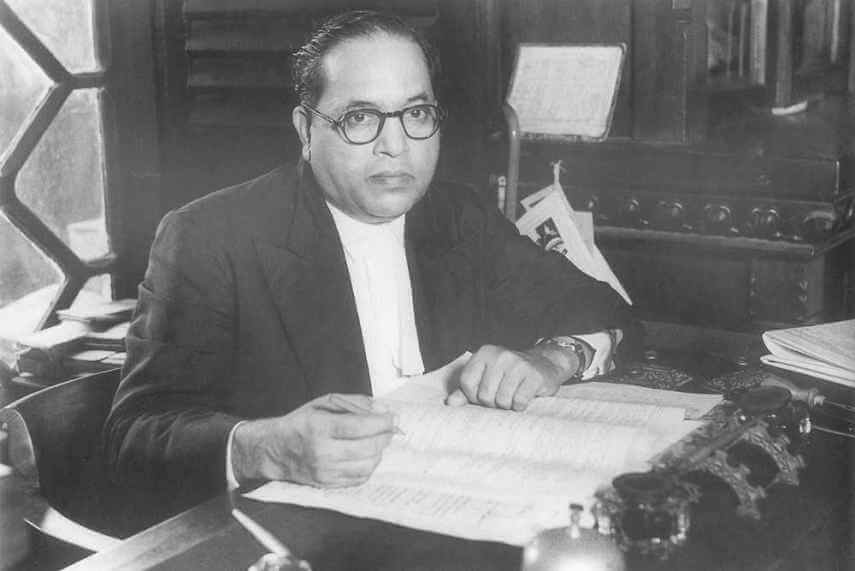 Bhimrao Ramji Ambedkar (14 April 1891 – 6 December 1956), popularly known as Dr. Babasaheb Ambedkar, was an Indian polytheist, jurist, economist, politician, and social reformer. He inspired the Dalit Buddhist movement and Campaigned against social discrimination from untouchables (Dalits). He also supported the rights of workers, peasants and women. He was the first Law and Justice Minister of independent India, the father of the Indian Constitution and the creator of the Republic of India.
Bhimrao Ramji Ambedkar (14 April 1891 – 6 December 1956), popularly known as Dr. Babasaheb Ambedkar, was an Indian polytheist, jurist, economist, politician, and social reformer. He inspired the Dalit Buddhist movement and Campaigned against social discrimination from untouchables (Dalits). He also supported the rights of workers, peasants and women. He was the first Law and Justice Minister of independent India, the father of the Indian Constitution and the creator of the Republic of India.
Born: April 14, 1891; Mhow, Central Provinces
Died: December 6, 1956 (aged 65); New Delhi
Spouse(s): Ramabai Ambedkar; Savita Ambedkar
Nationality: Indian
Ambedkar was a student of immense talent. He received doctoral degrees in economics from both Columbia University and the London School of Economics and also did research work in law, economics and political science. [7] He was a professor of economics and advocacy in the early part of professional life. Ki and later life was more spent in political activities.
Then Ambedkar became involved in publicity and discussions for the independence of India and was instrumental in publishing magazines, advocating political rights and advocating social freedom for Dalits and building India.
In 1956, he embraced Buddhism. In 1990, he was posthumously awarded the Bharat Ratna, India’s highest civilian honor. His birth anniversary Ambedkar Jayanti is celebrated as a festival on April 14 across India. Ambedkar’s legacy includes many monuments and depictions in popular culture.
Table of Contents
Early life
Ambedkar was born on 14 April 1891 in the Mahu Nagar Military Cantonment in the Central India Province (now Madhya Pradesh) of British India. His family The believer of Kabir Panth was of Marathi mool and he was a resident of village Ambadwe in Ratnagiri district of present-day Maharashtra.
He belonged to the Hindu Mahar caste, which was then called untouchable and due to this he had to bear deep discrimination socially and economically. Bhimrao Ambedkar’s ancestors had long served in the army of British East India Company. And his father Ramji Sakpal, serving in the Mhow cantonment of the Indian Army and while working here he rose to the rank of Subedar. He received formal education in Marathi and English.
Child Bhima was facing social resistance due to his caste. Despite being able to study in school, Bhimrao had to face many kinds of hardships due to untouchability. Ramji Ambedkar remarried from Jijabai in 1898. On 7 November 1900, Ramji Sakpal registered the name of his son Bhimrao Bambi Ramji Ambedwekar in the Government High School in Satara.
Bhiwa was his childhood name. Ambedkar’s original surname was written Ambedwekar instead of Sakpal, which was related to his village of Ambedwe. As the people of the Konkan province kept their surname after the village name, hence the Ambedvekar surname was recorded in Ambedkar village of Ambedkar in the school. Later Krishna Devdev Ambedkar, a Devrukhe Brahmin teacher who had special affection for him, removed his name ‘Ambedvekar’ from his name and added his simple ‘Ambedkar’ surname. Since then, he is known as Ambedkar.
Education
Ambedkar entered the first grade of English on 7 November 1900 at the Government High School (now Pratapsingh High School) located at Rajwara Chowk in Satara city. From this day onwards, his academic life started, so on November 7, Maharashtra is celebrated as Vidyarthi Divas. At that time he was called as ‘Bhiwa’.
When he passed the English fourth grade examination, because it was unusual among the untouchables, this success of Bhimrao was celebrated among the untouchables and in public function, and was written by his family friend Dada Keluskar himself. Biography of ‘He was gifted.
In 1897, Ambedkar’s family moved to Mumbai where he received further education at the Government High School on Elphinstone Road.
In 1907, he passed his matriculation examination and the following year he entered Elphinstone College, affiliated to the University of Bombay. He was the first from his community to receive education at this level.
Struggle against untouchability
Ambedkar said “untouchability is worse than slavery”. Ambedkar was educated by the princely state of Baroda, and was therefore obliged to serve him. He was appointed the military secretary of Maharaja Gaekwad, but due to caste discrimination he had to leave this job in no time.
he retried to find a means of livelihood for his growing family, for which he worked as an accountant, and as a private teacher. Also worked, and set up an investment consulting business, but all these efforts failed when his clients realized they were untouchables.
In 1918, he became a professor of political economics at Sydenham College of Commerce and Economics in Mumbai. Although he was successful with the students, other professors objected to sharing the pot of water with him.
Ambedkar, as a prominent scholar of India, was invited to testify before the Southborough Committee, preparing the Government of India Act 1919. During this hearing, Ambedkar advocated a separate electorate and reservation for Dalits and other religious communities. In 1920, from Bombay, he began the publication of the weekly Mooknayak.
This publication soon became popular among readers, when Ambedkar used it to criticize the reluctance of orthodox Hindu politicians and the Indian political community to fight caste discrimination. The speech given during a conference of his Dalit class greatly influenced the local ruler of Kolhapur state Shahu IV, who had a meal in the conservative society with Ambedkar.
While practicing law in the Bombay High Court, he made efforts to promote and uplift the education of untouchables. Their first organized effort was the establishment of the Central Institute of Excluded Hitakarini Sabha, which aimed at promoting education and socio-economic reform as well as the welfare of the “boycott” referred to as depressed classes. To protect Dalit rights , He took out five magazines like Mooknayak, Bahishkrit Bharat, Samata, Enlightened India and Janata.
In 1925, he was appointed to serve in the Simon Presidency with all European members in the Bombay Presidency Committee. Protests took place across India in protest against this commission. While its report was ignored by most Indians, Ambedkar sent a separate recommendation for future constitutional reforms.
In 1930, Ambedkar started the Kalaram Temple Satyagraha after three months of preparation. Around 15,000 volunteers gathered in the Kalaram temple movement, which led to Nashik’s biggest processions. When they reached the gate, the gates were closed by the Brahmin authorities.
Political Life
Ambedkar’s political career began in 1926 and until 1956 he held various positions in the political arena. In December 1926, the Governor of Bombay nominated him as a member of the Bombay Legislative Council; He took his duties seriously, and often gave speeches on economic matters. He was a member of the Bombay Legislative Council until 1936.
On 13 October 1935, Ambedkar was appointed the Principal of the Government Law College and served in this post for two years. He also served as the chairman of the governing body of this college after the death of Shri Rai Kedarnath, the founder of Ramjas College, University of Delhi. Ambedkar settled in Bombay (now Mumbai), he built a three-storey big house here ‘ Rajagriha, which had more than 50,000 books in his private library, was the largest private library in the world at that time.
In 1936, Ambedkar founded the Independent Labor Party, which won 13 seats in the Central Legislative Assembly elections in 1937. Ambedkar was elected as the MLA of the Bombay Legislative Assembly. He remained a member of the Legislative Assembly until 1942 and during this time he also served as the Leader of the Opposition in the Bombay Legislative Assembly.
In the same year, Ambedkar published his book ‘Annihilation of Caste‘ (Destruction of Caste System) on 15 May 1936, which was based on a paper written in New York. In this book, Ambedkar described Hindu religious leaders and caste system. Strongly criticized. He strongly condemned the Congress’s decision to call Gandhiji the word Harijan to the untouchable community.
Later, in a 1955 BBC interview, he accused Gandhi of supporting the caste system in his Gujarati language papers and opposing the caste system in English language papers.
The All India Scheduled Castes Federation was a socio-political organization founded by Ambedkar in 1942 to campaign for the rights of the Dalit community. During the years 1942 to 1946, Ambedkar served as the Minister of Labor on the Defense Advisory Committee and the Viceroy’s Executive Council.
